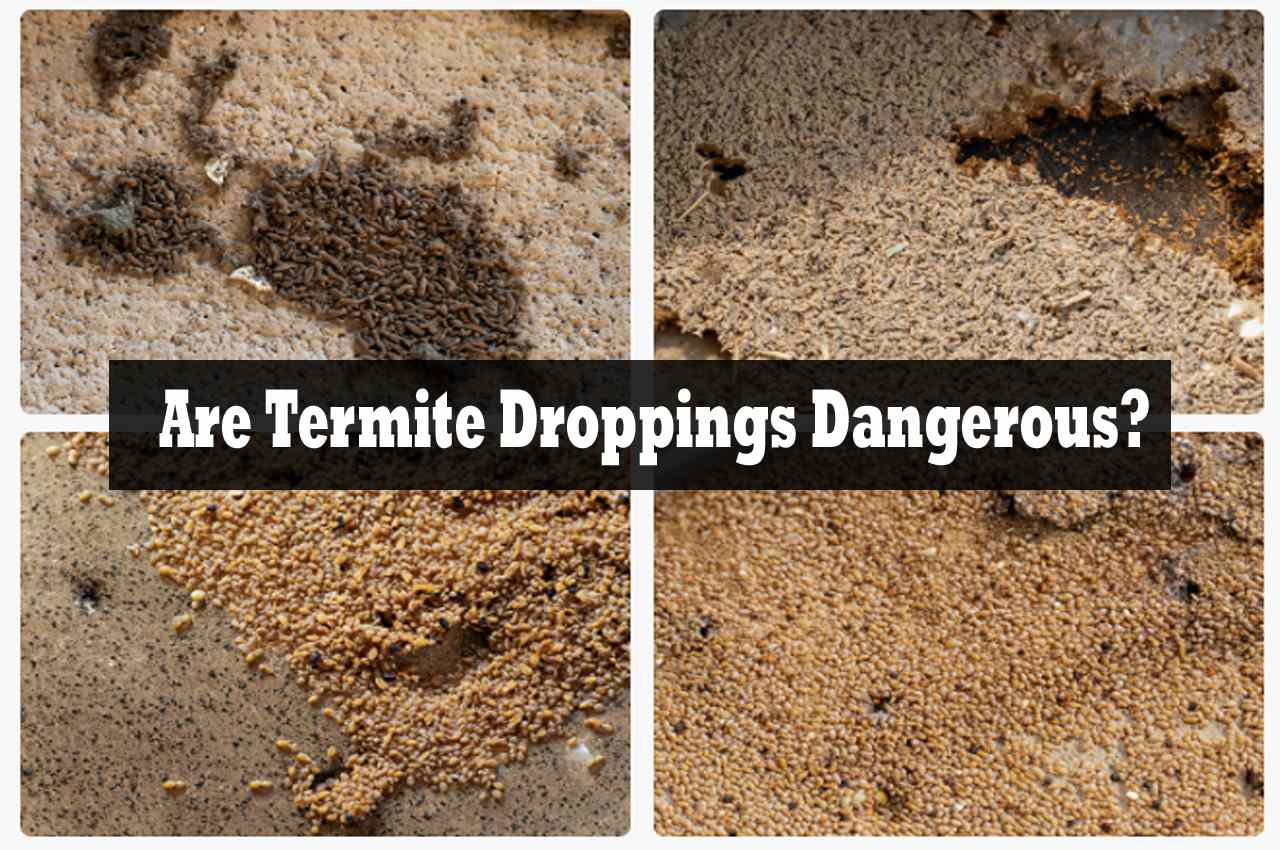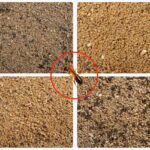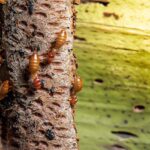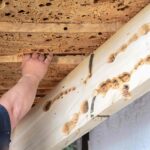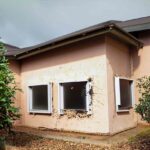Many people ask, are termite droppings dangerous to touch? It’s best to avoid direct contact, but they are not very much harmful. Termite frass, commonly known as termite droppings, is a typical indicator of a termite infestation. But are they really harmful to people? Here is a thorough explanation of what termite droppings is, how it appears, the health dangers it poses, and what you should do if you discover it in your house.
Dangers of Termite Droppings
| Type of Danger | Description | Precautions |
|---|---|---|
| Structural Damage | Droppings signal termites are destroying wood structures | Call a pest control professional immediately upon seeing droppings |
| Respiratory Issues | Inhaling wood dust can irritate lungs | Wear a mask when cleaning up droppings |
| Skin Irritation | Digestive enzymes can cause rashes | Avoid direct contact with droppings |
| Mold Exposure | Termites spread moisture that encourages mold growth | Use mold inhibiting paints after fixing leaks |
What is Termite Droppings?
Termite waste and excrement are what are often referred to as termite droppings, or frass in scientific terminology. It contains digestive enzymes, termite body pieces, and undigested wood and soil particles.
Termites consume the cellulose in wood and other plant materials to produce frass. The excretions are discharged from the anus and gather in mounds close to termite infestations.
What Does Termite Droppings Look Like?
Typically, termite poops or frass looks like tiny sand or sawdust particles. Usually, the color is the same as the wood that termites are consuming. Frass from termites consuming oak, for instance, will appear tan or brown.
The excretions are often smaller than 1 mm in size. They are oblong or oval-shaped with rounded ends and concave sides. The small pellets might disperse randomly or cling together in groups.
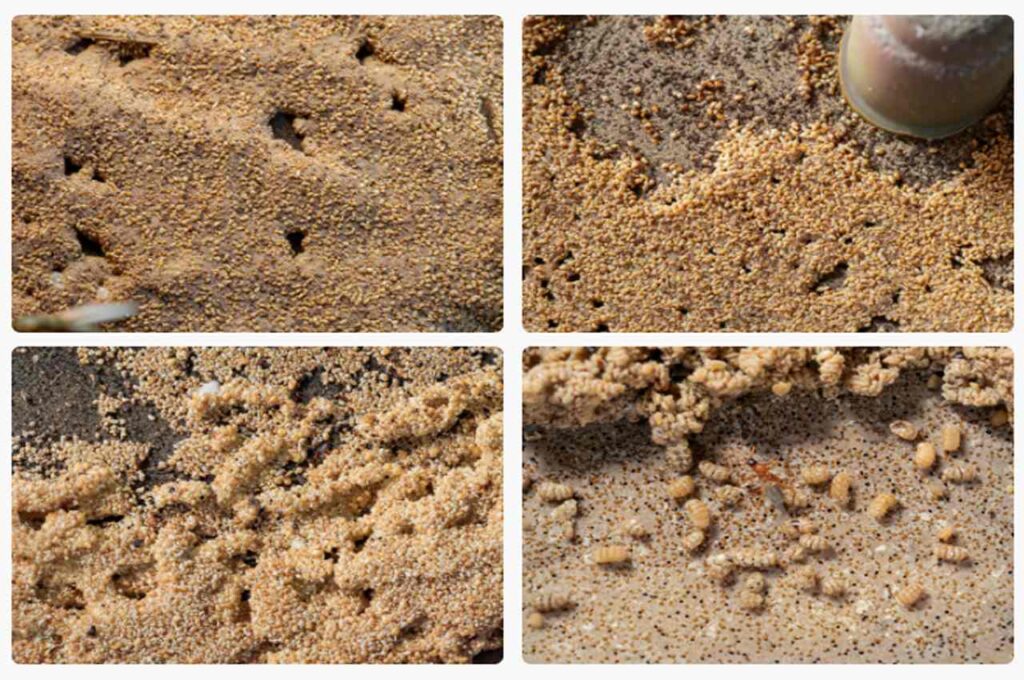
You’ll often find termite droppings:
- Along window sills and baseboards
- On carpet borders or below furniture
- Inside crevices in the floors, walls, or ceilings
- Close to sources of moisture, such as sinks or bathtubs
Appearance of Termite Droppings by Species
| Termite Species | Dropping Appearance | Dropping Color |
|---|---|---|
| Subterranean | Fine sand-like grains | Brown or black |
| Drywood | Oval-shaped pellets | Tan or brown |
| Dampwood | Small cylindrical pellets | Black or dark brown |
Are Termite Droppings Dangerous?
The answer to the question, “Are termite droppings dangerous,” is usually “no,” since they do not constitute a serious concern. Frass, the term for termite droppings, is typically not thought to be harmful to people. They don’t contain any dangerous poisons and are comprised mostly of cellulose, the substance that makes up wood. However, there are certain possible health hazards connected to termite droppings, such as:
- Allergic responses: Some individuals, particularly those who have asthma or other respiratory disorders, may have allergic reactions to termite droppings. Sneezing, coughing, wheezing, and breathing difficulties are all possible signs of an allergic response.
- Skin rashes: Termite droppings may also cause skin rashes, particularly if touched. Redness, itching, and a burning feeling are some signs of skin irritation.
- Respiratory issues: Termite poop inhalation may aggravate the lungs and airways, which can result in respiratory issues including asthma and bronchitis. Those who already have respiratory issues are particularly at danger.
Termite droppings are a symptom of a termite infestation in addition to these health dangers. It is crucial to act quickly to get rid of termites since they may seriously harm houses and other buildings.
Therefore, even while termite dung isn’t immediately harmful, it might reveal greater health risks are present or about to occur within a house.
Why is Termite droppings Harmful?
Termite droppings primarily hurt you because they indicate an active infestation within your house, which may cause skin rashes or allergies. This results in:
- Costly repairs – Termites consume wood, drywall, furniture, flooring, books, and more. Repairing the structural damage might cost thousands of dollars.
- Lower property value – Termite infestations must be mentioned when selling a house, which will lower the property value. Usually, this depresses property value.
- Risk of collapse – Severe termite infestations may seriously damage load-bearing walls or other structural components, raising the possibility of a collapse.
- Mold issues – Moisture leaks from termite damage promote the development of mold in ceilings and walls. Inhaling mold spores poses health risks.
In conclusion, termite frass is a sign that significant property damage is about to occur or has already begun. The cost of mending will decrease the faster therapy starts.
Termite Droppings and Human Health
Even while termite droppings don’t carry illnesses or contain poisons, they may nonetheless harm people’s health in a number of ways.
| Health Risk | Description |
|---|---|
| Respiratory issues | Inhaling wood dust can cause coughing, congestion, asthma |
| Eye irritation | Wood dust irritates eyes, causes watering and redness |
| Skin irritation | Rashes, infections, or dermatitis from direct contact |
| Illness | Bacteria and fungi on droppings can infect open cuts or wounds |
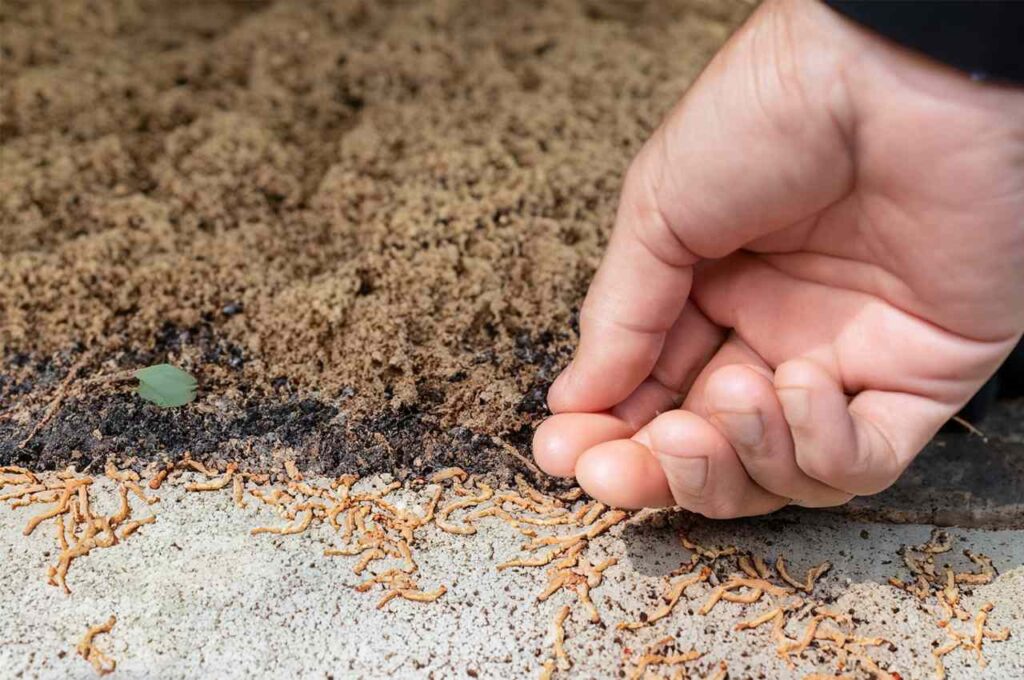
- Dry frass particles are readily inhaled and may trigger asthma episodes, congestion, or coughing in susceptible individuals.
- The wood dust in the droppings might irritate the nasal passages, skin, and eyes.
- Mold spores from moist locations are transferred into dwelling spaces by termite activity.
- Termite droppings include fungi and bacteria that, if handled, may infect cuts or open wounds.
- People with allergies or skin sensitivities who come into touch with droppings may get rashes or dermatitis.
For these reasons, it’s a good idea to take safety measures while handling or cleaning up termite frass, such as donning gloves and a mask. Removing termite infestations quickly also lowers health concerns.
Termite Droppings risk to Pets
When exposed to termite droppings, dogs and cats have comparable sensitivities and health hazards, including:
- An allergic reaction to frass if breathed
- Infections or skin rashes brought on by direct touch
- Irritation of the eyes, nose, and throat caused by airborne particles
- Problems with the stomach or intestines if droppings are consumed

If exposed repeatedly to the droppings and wood dust, pets that are prone to allergies or who have compromised immune systems may get sick in particular. It is advisable to keep them away from regions containing frass.
Dangers to Wood Structures
Termites eat anything that contains cellulose, primarily wood and wood products. This makes the home’s structural wood, structure, and architectural components their primary targets.
Different termite species exhibit various eating and destructive behaviors:
- In soil, subterranean termites establish sizable colonies. They hollow out the wood by digging a tunnel up into the interior. A layered, shredded look is the result.
- Inside wood, drywood termites create tiny colonies. They drill holes of the same diameter and force the frass out. Surfaces are left with a “shotgun” dispersion pattern as a result.
- Only wood with a greater moisture content is consumed by dampwood termites. They expand the fissures and grain lines that already present. This results in crooked, winding tunnels.
The final effect is always severely weakened structural integrity. The next-fastest wood decomposer after fungus is 10 times slower than termites.
Signs of Termite droppings
Keep an eye out for these indicators that your property may have termite droppings:
- Tiny clumps of sawdust or fine sand close to wood sources
- Very little oblong pellets close to baseboards, window sills, or floor margins
- Debris that matches the color of the nearby wood
- Musty odors without any visible water leaks
- Coughing or inflamed eyes near particular locations, as well as allergy symptoms
Near furniture legs, baseboards, or floor fissures, where it’s less likely to be routinely wiped away, is where termite droppings is easiest to see.
What to Do If You Find Termite droppings?
Although finding termite frass or droppings within your house is concerning, doing the following actions might be helpful:
- When investigating the afflicted region, put on gloves, long sleeves, closed-toed shoes, safety glasses, and a mask for your protection. Avoid touching your skin too much to the droppings.
- Keep track of where the termite droppings are—for example, next to specific walls, baseboards, and furniture legs. Also take note of any cracked or leaking pipes, as well as any excessive wetness.
- For an inspection, speak with a qualified termite control specialist. They can confirm that it is termite droppings and suggest possible remedies.
- Discuss appropriate eradication techniques, such as tenting, fumigation, bait systems, etc., if termite activity is discovered. Compare each’s benefits and drawbacks.
- Repair any structural or water damage caused by termites after they have been exterminated. If necessary, use mold-inhibiting paints or treatments.
- Follow preventive actions, such as maintaining dry crawl spaces, caulking cracks, and removing vegetation away from the outside of your property.
Termite droppings don’t have to mean doom for your home’s foundation or health if you act quickly. Keep an eye out for warning indicators like frass heaps and seek expert assistance as soon as you notice an infestation.
Conclusion
Although termite droppings don’t always pose health risks, they may indicate costly structural damage, mold development, and other issues that might be present in an infected property. Do not disregard any little heaps of shady material in your home that resemble sawdust. Termite droppings are an indication of a problem that, if ignored, will only become worse. Prior to the need for significant house repairs, thoroughly inspect suspicious areas, get expert evaluations, and take steps to exterminate termites. Termite droppings don’t have to mean catastrophe for the structure of your house or the health of your family if you act quickly.
Frequently Asked Questions
Can you get sick from termite droppings?
Yes, exposure to termite droppings may have negative effects on one’s health. A person with weakened immunity may be more at risk of experiencing respiratory problems, skin and eye irritation, nausea, or stomach pain after inhaling termite droppings. Although termite poop itself is not poisonous, it may produce mold spores and wood dust, which make these health problems worse. To reduce these health risks, it’s critical to take safeguards and eliminate termite infestations quickly. Once exposed, if any unsettling symptoms appear, get medical help.
Are termite droppings toxic to humans?
No, hazardous chemicals are not present in termite droppings (frass). They may nevertheless be harmful to human health. If breathed, the wood dust in the droppings might irritate the eyes and lungs. They also include digestive enzymes, which when in touch with the skin, may irritate it and lead to rashes or dermatitis. When exposed to termite dung, those with allergies or weak immune systems may react severely. Since termites live in moist environments where mold may develop, there are other hazards associated with mold exposure. Their excretions may disperse spores into habitations. Despite the fact that termite frass is not toxic directly, care should nevertheless be taken around regions where it collects.
What diseases can humans catch from termite droppings?
Termite droppings do not carry bacteria that are dangerous to people or spread contagious illnesses. However, the droppings operate as a breeding ground for germs, fungus, and mold. If exposed often to termite dung, those with chronic diseases or immune systems that are already impaired are more likely to get opportunistic infections. If someone with a chronic lung ailment like COPD inhales mold spores generated by termite frass, for instance, a respiratory infection might result. Or if termite droppings come into direct touch with someone’s open leg sores, they can get a skin infection. However, termite dung only provides a minor risk of sickness for the majority of healthy people if basic safeguards are taken.
Should I be concerned if my child or pet eats termite droppings?
There is really little reason for alarm if a little quantity of droppings is consumed. However, termite frass may include fungi, mold, or bacteria that, if consumed in high amounts, might irritate the stomach. Look out for signs such as nausea, vomiting, or lack of appetite. Additionally, the excrement may get stuck in a pet’s teeth, leading to dental problems. If worrying symptoms arise following potential termite dung consumption, make sure your kid or pet is evaluated by a doctor or veterinarian. If a youngster consumes more than a little piece of excrement, contact Poison Control immediately. To minimize recurrent exposure, take precautions include clearing away frass, limiting access to impacted areas, and managing the termite infestation.
How do you clean termite droppings?
Cleaning termite frass should be done with attention to reduce health concerns. To avoid skin contact, put on gloves, long sleeves, and closed-toed shoes. To prevent breathing in wood dust, use a face mask made for fine dust. Take your time to avoid stirring up too much dust. Droppings may be dampened with a fine spray to reduce airborne particulates. Avoid using a typical vacuum since the exhaust airflow from these machines might spread dust. Instead, if at all feasible, use a vacuum with a HEPA filter. Put waste animal droppings in a sealed plastic bag. Wash exposed skin and contaminated clothes separately after cleaning. Future droppings may be decreased by maintaining moisture management and removing termite access sites.
When should I be concerned about termite droppings in my home?
Termite dung accumulations of any size need investigation. The droppings are most likely an indication that termites are aggressively destroying the wooden structural components of your house. Significant damage may be taking place below floors and behind walls. Severe structural flaws and costly repairs may develop if left addressed. Termite-caused water leaks may promote the formation of hazardous mold. Even minute quantities of termite frass may cause irritation if you are allergic to dust or allergies. At the first indication of droppings, take action. To find infestations, get rid of termites, and stop future ones, see a termite management expert. Any moisture problems or property damage should be handled appropriately. Keep an eye out for more droppings and treat any fresh termite symptoms right once.
What are the risks if my dog eats termite droppings?
A modest quantity of termite frass consumed by a dog is unlikely to have any serious consequences. However, consuming a lot of excrement may result in gastrointestinal distress, such as vomiting, diarrhea, or appetite loss. Additionally, the wood dust may get stuck in a dog’s teeth or gums, causing dental issues. In rare instances, if a dog’s immune system is weakened, the mold, fungus, or bacteria on the droppings might make them ill. If your dog enters regions that have termite droppings, keep a tight eye on them. Watch out for signs including rashes, vomiting, hiccups, and exhaustion. If any worrying symptoms appear, contact your veterinarian. By removing droppings, limiting access to impacted areas, and treating the termite infestation, you may prevent recurrent exposure.
Can inhaling termite droppings worsen asthma?
Inhaling termite frass might aggravate asthma or cause asthma attacks. Microparticles in the wood dust irritate the respiratory tract. Asthma may also become worse due to mold spores emitted from moist termite droppings. Inhaling termite dung material puts those with chronic respiratory conditions like COPD at greater risk. Avoid exposure to termite droppings and be cautious about eradicating termite infestations if you or a family member already has respiratory conditions. When clearing up debris, put on a N95 face mask. Dust may be reduced by spraying poop before sweeping it up. To lower health hazards, fix any moisture issues that are attracting termites and increase airflow throughout your house.
How often should I inspect my home for new termite droppings?
It’s a good idea to properly examine your house for termite droppings at least twice every season, or four times a year. When termites are active in the spring, droppings may initially emerge. But as infestations grow and spread, fresh frass may appear at any moment. Check furniture legs, baseboards, windowsills, attics, crawl spaces, and any other place where wood and dirt come into contact. In order to find empty spaces, tap around the walls and flooring. To inspect concealed sections, pull aside insulation. If there was a prior infestation, pay more attention to the places where droppings were initially seen. Avoid going years without an examination. The key to reducing damage from the cunning termites is catching fresh frass as soon as possible.
What precautions should I take when cleaning termite droppings in an attic?
Extra measures must be used while cleaning up termite frass in an attic. In the enclosed attic, wood dust and mold spores may build up to significant amounts. Additionally, insulation fibers that contain respiratory irritants are mixed together with the excrement. Dress in long sleeves, closed-toed shoes, a N95 mask, gloves, and goggles. You should dampen droppings before sweeping to prevent stirring up particles. To manage dust, use a vacuum with HEPA filtration. Short bursts of work are followed by pauses to get some fresh air. To ventilate, turn on the exhaust fans. Instead of dropping it through ceiling apertures, bag up the garbage. When you have finished cleaning the attic, take a shower and get dressed. Attic ventilation may be improved to assist prevent more droppings.
- How do termite mounds help regulate temperature? - 7 January 2024
- 10 Effective Termite Control Methods That Actually Work - 4 January 2024
- How Long Does It Take for a Termite Mound to Form? - 21 December 2023
